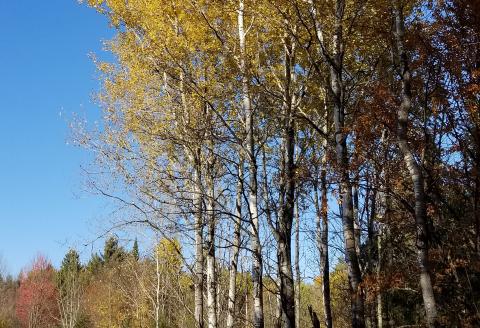Looking for Aspen

A Colorado ski town is named after it, and Fishlake National Forest in Utah boasts the largest and oldest grove of it, which is also one of the world’s largest organisms. Aspen, known in New England as popple or poplar, is a well-known tree. Its bright yellow leaves in fall are often among the last colors to paint the graying hillsides. It provides important habitat for wildlife and plays a strong role in North America’s forest industry.
Description
Aspen is in the genus Populus, hence the common name popple or poplar. It is not to be confused with yellow or tulip poplar, which is a different genus and species and generally found further south. The two main species of aspen in New Hampshire are quaking and bigtooth. Quaking aspen has small, almost round leaves one to three inches across with serrated edges and a flat stem, or petiole, connecting the leaf to the twig. This petiole is what causes the leaves to twist rapidly in a mild breeze, giving the tree its name. Bigtooth aspen leaves are larger than quaking, at two to five inches across. The leaf edges are large serrations, hence the name “big tooth”.
Range
Quaking aspen grows from Labrador through New England to New Jersey. It is found across the Lake States and Canada, up to the tundra, and northwest into interior Alaska, then down through the inland northwest. In the southwest, it grows in higher elevations, its southernmost population found in central Mexico. Bigtooth aspen has a smaller range, from the Great Lakes region east to Maine and the Maritimes.
Both species have smooth, light gray or white bark when young, and sometimes immature trees have green bark. As trees mature, the bark develops vertical grooves, especially on bigtooth aspen. Bark on a mature bigtooth’s lower trunk can sometimes look like other trees such as sugar maple. The smooth white bark on the tree’s upper stem confirms its identity.
A Pioneer
Aspens are pioneer species, the first to occupy a heavily disturbed site, whether from fire, logging, or landslide. They have very small, light seeds carried by wind, enabling the seed to find disturbed mineral soil far from the parent tree. The main reproductive strategy, however, is through root sprouts or suckers. If aspen was present on a site prior to the grove’s removal, the root system will quickly send up suckers, which become the next stand of trees. Trees that develop from the root system of one tree are clones. The aspen grove in Utah is a single clone, which is why, at 106 acres, this stand is considered one of the largest single organisms in the world. Named Pando, Latin for “I spread”, it weighs an estimated thirteen million tons.
With an average lifespan of 50 to 70 years, aspen trees are relatively short lived. Some trees on excellent sites, live to one hundred or older, and bigtooth aspen tends to live longer than quaking aspen. The root system, by contrast, can live hundreds of years.
Wildlife Habitat
Aspen provides important habitat for numerous species associated with young forest. Dense sapling and poletimber stands provide breeding and nesting cover for ruffed grouse and woodcock, and aspen flower buds on mature trees provide important winter food for grouse. Aspen buds, twigs, and bark are favored foods of beaver, moose, snowshoe hares, and cottontail rabbits.
The soft, easily excavated wood makes larger aspen a favorite of woodpeckers, which excavate nesting cavities. Chickadees, tufted titmice, and yellow-bellied sapsuckers also create nesting cavities in aspen. After woodpeckers stop using them, cavities are often occupied by eastern kingbirds.
An overlooked factor of aspen is the genus’ importance as a caterpillar host. According to UNH Extension Wildlife Specialist Matt Tarr, aspen “serves as a host plant to about 367 species of moth and butterfly caterpillars…this makes it the fifth ranked genus in the list of plants that support the greatest number of caterpillar species in the eastern US (#1-5 are: oak, cherry, willow, birch, aspen)”. These caterpillars are food for numerous bird species.
Products
Aspen is used for a variety of products, primarily pulp for papermaking. Others include plywood, oriented strand board, and furniture applications where the soft wood will not receive a lot of wear. An interesting use is for sauna benches because the wood doesn’t splinter.
Aspen markets in New England are mainly for pulpwood, with occasional demand for sawlogs or veneer. Aspen is not a desired firewood because it has low heat per cord compared to red oak or sugar maple. It does have an advantage because it dries in six months, while sugar maple and oak take up to two years. In my experience it burns quickly and is useful for getting a fire going.

Management
Aspen is easily regenerated, but it is shade intolerant, so it needs large openings of at least an acre to thrive. A decline in fires and clearcutting has led to a decline in the amount of aspen on the landscape, except along fields, roads, and powerline rights-of-way. Larger blocks of five to twenty acres that are important for grouse and other birds are less prevalent. Periodic disturbance is necessary to maintain aspen in the woods because uncut or partially cut stands will prevent or inhibit aspen growth. Without disturbance, the species will gradually fade out of the forest. Patch clearcutting is the easiest way to regenerate aspen.
When managing for grouse, three age classes of aspen are needed: sapling stage from four to fifteen years old for brood cover; sapling and pole stands from fifteen to twenty-five years old for fall and spring cover, and mature aspen over twenty-five years old to provide buds for food. Newly cut patches make a fourth age class. Managing aspen for ruffed grouse also benefits woodcock and other species.
A forester can help design and implement a harvest schedule to perpetuate aspen for grouse and other wildlife. Like all tree species, aspen should be grown and regenerated where it fits the site, the landowner’s goals, and the surrounding landscape.
Aspen is an important tree species and forest type in New Hampshire, providing habitat, aesthetic appeal, and wood products. It is easy to regenerate, but it needs to be managed purposefully in order to ensure it remains a component of our forest.
Sources:
- DeGraaf, Richard M. and Mariko Yamasaki. (2001). New England Wildlife: Habitat, Natural History, and Distribution. Hanover, NH: University Press of New England.
- Dessecker, D. (n.d.). Managing Aspen. Retrieved from www.ruffedgrousesociety.org.
- Gullion, G.W. (1984). Managing Northern Forests for Wildlife. Publication No. 13,442, Miscellaneous Journal Series, Minnesota Agricultural Experiment Station, St. Paul.
- US Forest Service. Pando. (n.d.) Retrieved from Fishlake National Forest website: https://www.fs.usda.gov/detail/fishlake/home/?cid=STELPRDB5393641
- Personal correspondence with Matt Tarr, PhD. University of New Hampshire Extension Wildlife Specialist.
